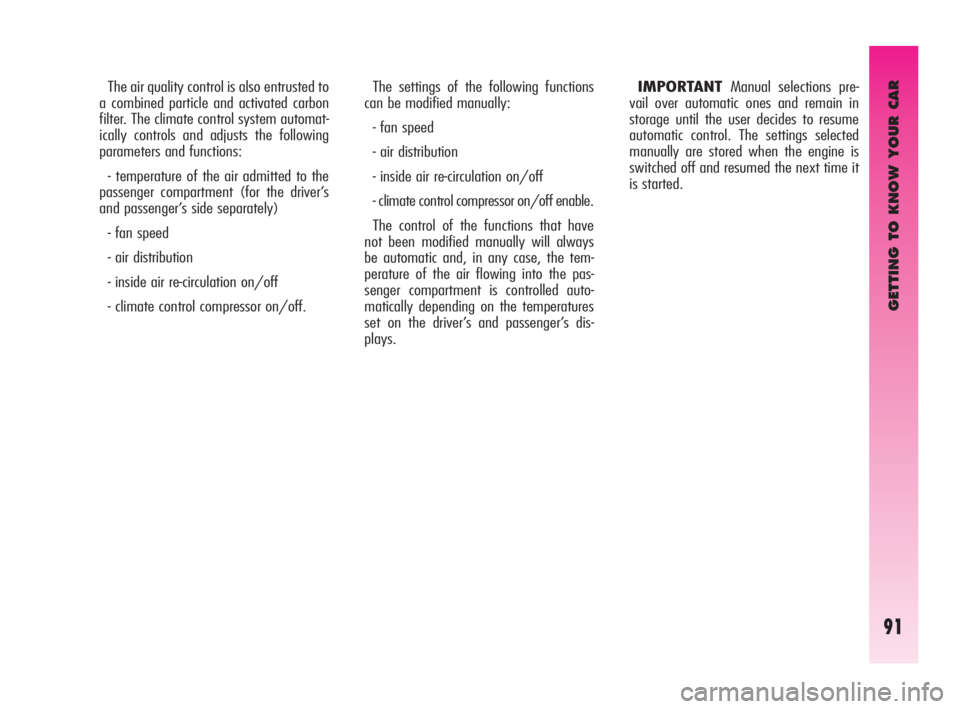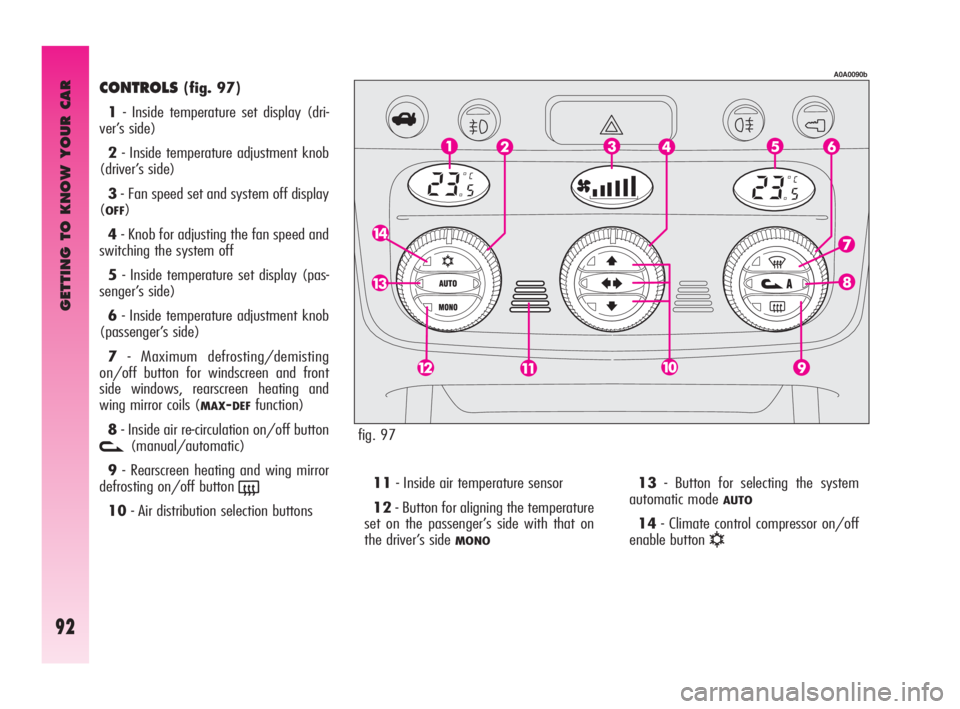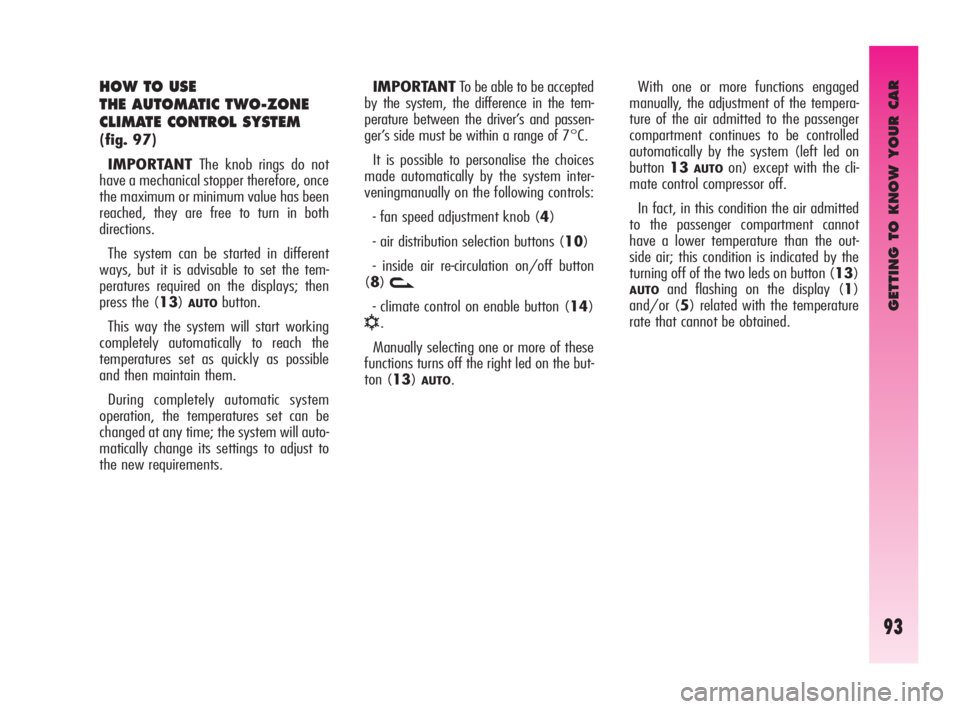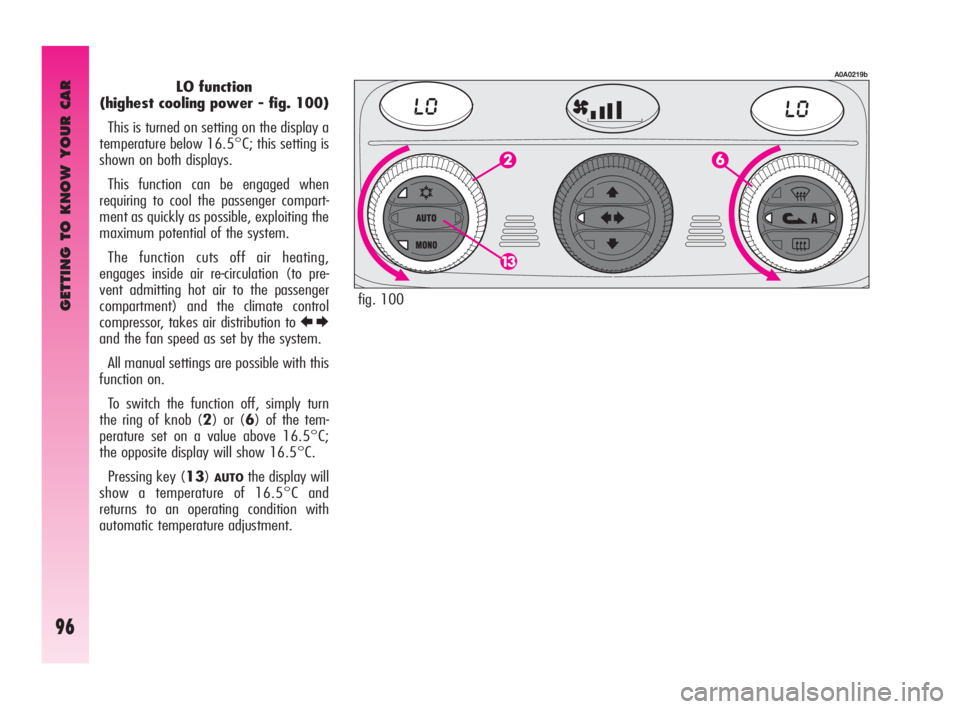Alfa Romeo GT 2010 Owner handbook (in English)
Manufacturer: ALFA ROMEO, Model Year: 2010, Model line: GT, Model: Alfa Romeo GT 2010Pages: 271, PDF Size: 5.34 MB
Page 91 of 271

GETTING TO KNOW YOUR CAR
89
AUTOMATIC TWO-ZONE CLIMATE CONTROL SYSTEM
(for versions/markets where applicable)
To start the system (fig. 96):
- turn the knob rings to set the required
temperatures (driver’s side - passenger’s
side).
- press the
AUTObutton.
IMPORTANTThe climate control sys-
tem makes it possible to personalise the
temperatures required on the two side
with a maximum difference of 7°C
between the driver’s side and the passen-
ger’s side.
IMPORTANTThe climate control com-
pressor can only work with the engine run-
ning and external temperature not very
low. With low external tem-
perature the climate con-
trol compressor is unable
to work. It is therefore inadvisable
to use the inside air recirculation
function vwith low outside tem-
perature as windows may mist
over quickly.
For further details about the system and
how to make the best use of it, read the
instructions given in pages that follow.
A0A0203b
fig. 96
The coolant used for the
climate control system is
R134a which meets cur-
rent regulations and does not harm
the environment in the event of ac-
cidental spillage.
Absolutely avoid the use of oth-
er fluids which are incompatible
with the system components.
Page 92 of 271

GETTING TO KNOW YOUR CAR
90
IMPORTANTThe demisting procedire
is enabled each time the ignition key is
turned to MARor pressing the button
AUTO. When this procedure is working it
can be turned off pressing one of the fol-
lowing buttons : compressor, air recircula-
tion, air distribution, air flow. This opera-
tion inhibits the incipient misting sensor
signal until the button
AUTOis pressed
again or the next time the ignition key is
turned to MAR.On certain versions, the system is inte-
grated by an antipollution sensor capable
of automatically switching on inside air
recirculation to lessen the harmful effects
of polluted air in cities, queues, tunnels
and operation of the windscreen washer
(with the typical smell of spirits).
IMPORTANT The function of the
antipollution sensor is subordinate to safe-
ty conditions; therefore disabling the cli-
mate control compressor or with low exter-
nal temperature, the sensor is disabled. In
any case, the sensor can be re-enabled
pressing the recirculation button
vuntil
taking it to the automatic mode. To ensure correct opera-
tion of the incipient mist-
ing sensor, stickers must
not be applied (road licence holder,
time card etc.). Care should also be
given to cleaning the windscreen
and the actual sensor, avoiding the
accumulation of dust and other sub-
stances.
GENERAL
The car is fitted with a two-zone climate
control system, controlled by an electronic
control unit which makes it possible to
separately adjust the air temperature on
the driver’s side and on the passenger’s
side. To obtain optimum temperature con-
trol in the two areas of the passenger
compartment, the system has an outside
sensor, a passenger compartment sensor
and a two-zone sun ray sensor.
On some versions the system is integrat-
ed with an incipient misting sensor
installed behind the inside rear-view mir-
ror, capable of “controlling” a predefined
area of the windscreen inner surface
which can automatically act on the system
to prevent or reduce misting through a
series of operations such as: opening air
re-circulation, enabling the compressor, air
flow to the windscreen, fan speed suffi-
cient for demisting; in the case of heavy
misting, enabling the
MAXDEFfunction.
Page 93 of 271

GETTING TO KNOW YOUR CAR
91
The air quality control is also entrusted to
a combined particle and activated carbon
filter. The climate control system automat-
ically controls and adjusts the following
parameters and functions:
- temperature of the air admitted to the
passenger compartment (for the driver’s
and passenger’s side separately)
- fan speed
- air distribution
- inside air re-circulation on/off
- climate control compressor on/off. The settings of the following functions
can be modified manually:
- fan speed
- air distribution
- inside air re-circulation on/off
- climate control compressor on/off enable.
The control of the functions that have
not been modified manually will always
be automatic and, in any case, the tem-
perature of the air flowing into the pas-
senger compartment is controlled auto-
matically depending on the temperatures
set on the driver’s and passenger’s dis-
plays.IMPORTANTManual selections pre-
vail over automatic ones and remain in
storage until the user decides to resume
automatic control. The settings selected
manually are stored when the engine is
switched off and resumed the next time it
is started.
Page 94 of 271

GETTING TO KNOW YOUR CAR
92
CONTROLS(fig. 97)
1- Inside temperature set display (dri-
ver’s side)
2- Inside temperature adjustment knob
(driver’s side)
3- Fan speed set and system off display
(
OFF)
4- Knob for adjusting the fan speed and
switching the system off
5- Inside temperature set display (pas-
senger’s side)
6- Inside temperature adjustment knob
(passenger’s side)
7- Maximum defrosting/demisting
on/off button for windscreen and front
side windows, rearscreen heating and
wing mirror coils (
MAX-DEFfunction)
8- Inside air re-circulation on/off button
v(manual/automatic)
9- Rearscreen heating and wing mirror
defrosting on/off button
(
10- Air distribution selection buttons 11- Inside air temperature sensor
12- Button for aligning the temperature
set on the passenger’s side with that on
the driver’s side
MONO
13- Button for selecting the system
automatic mode
AUTO
14- Climate control compressor on/off
enable button
√
fig. 97
A0A0090b
Page 95 of 271

GETTING TO KNOW YOUR CAR
93
HOW TO USE
THE AUTOMATIC TWO-ZONE
CLIMATE CONTROL SYSTEM
(fig. 97)
IMPORTANTThe knob rings do not
have a mechanical stopper therefore, once
the maximum or minimum value has been
reached, they are free to turn in both
directions.
The system can be started in different
ways, but it is advisable to set the tem-
peratures required on the displays; then
press the (13)
AUTObutton.
This way the system will start working
completely automatically to reach the
temperatures set as quickly as possible
and then maintain them.
During completely automatic system
operation, the temperatures set can be
changed at any time; the system will auto-
matically change its settings to adjust to
the new requirements. IMPORTANTTo be able to be accepted
by the system, the difference in the tem-
perature between the driver’s and passen-
ger’s side must be within a range of 7°C.
It is possible to personalise the choices
made automatically by the system inter-
veningmanually on the following controls:
- fan speed adjustment knob (4)
- air distribution selection buttons (10)
- inside air re-circulation on/off button
(8)
v
- climate control on enable button (14)
√.
Manually selecting one or more of these
functions turns off the right led on the but-
ton (13)
AUTO.With one or more functions engaged
manually, the adjustment of the tempera-
ture of the air admitted to the passenger
compartment continues to be controlled
automatically by the system (left led on
button13
AUTOon) except with the cli-
mate control compressor off.
In fact, in this condition the air admitted
to the passenger compartment cannot
have a lower temperature than the out-
side air; this condition is indicated by the
turning off of the two leds on button (13)
AUTOand flashing on the display (1)
and/or (5) related with the temperature
rate that cannot be obtained.
Page 96 of 271

GETTING TO KNOW YOUR CAR
94
AIR TEMPERATURE
ADJUSTMENT KNOBS
(fig. 98)
Turning the rings of knobs (2or6),
clockwise or counter-clockwise, respective-
ly highers or lowers the temperature of
the air required respectively in the left
zone (knob 2) or right zone (knob 6) of
the passenger compartment. The temper-
atures set are shown on the displays (1)
and (5) above the knobs.
Separate operation of the temperatures
set is restored automatically using knob
(6).
Turning the knob rings clockwise or
counter-clockwise until they reach the
extreme selections HIorLO, the maxi-
mum heating or cooling functions are
respectively engaged:
A0A0204b
fig. 98
Page 97 of 271

GETTING TO KNOW YOUR CAR
95
HI function
(highest heating power - fig. 99)
This is turned on setting on the display a
temperature above 32.5°C, and can be
activated independently from the driver’s
or passenger’s side or both; this setting
brings the system to the “monozone”
mode and is shown on both displays.
This function can be engaged when
requiring to heat the passenger compart-
ment as quickly as possible, exploiting the
maximum potential of the system.
This function uses the maximum temper-
ature of the coolant fluid, while air distrib-
ution and fan speed are controlled accord-
ing to the system settings.
This function is unadvisable with
the engine cold to prevent admit-
ting air that is not warm enough
to the passenger compartment.
All manual settings are possible with this
function on.
To switch the system off, simply turn the
ring of knob (2) or (6) of the tempera-
ture set to a value below 32.5°C; the
opposite display will show 32.5°C.
A0A0218b
fig. 99
Pressing key (13)
AUTOthe display will
show a temperature of 32.5°C and returns
to an operating condition with automatic
temperature adjustment.
Page 98 of 271

GETTING TO KNOW YOUR CAR
96
LO function
(highest cooling power - fig. 100)
This is turned on setting on the display a
temperature below 16.5°C; this setting is
shown on both displays.
This function can be engaged when
requiring to cool the passenger compart-
ment as quickly as possible, exploiting the
maximum potential of the system.
The function cuts off air heating,
engages inside air re-circulation (to pre-
vent admitting hot air to the passenger
compartment) and the climate control
compressor, takes air distribution to
RE
and the fan speed as set by the system.
All manual settings are possible with this
function on.
To switch the function off, simply turn
the ring of knob (2) or (6) of the tem-
perature set on a value above 16.5°C;
the opposite display will show 16.5°C.
Pressing key (13)
AUTOthe display will
show a temperature of 16.5°C and
returns to an operating condition with
automatic temperature adjustment.
A0A0219b
fig. 100
Page 99 of 271

GETTING TO KNOW YOUR CAR
97
MONO BUTTON FOR
ALIGNMENT OF THE
TEMPERATURE SET
(fig. 101)
Pressing button (12)
MONOautomati-
cally aligns the temperature on the pas-
senger’s side with that on the driver’s
side, therefore it is possible to set the
same temperature between the two zones
simply turning the ring of knob (2) on the
driver’s side.
This function is provided to simplify tem-
perature adjustment of the whole passen-
ger compartment when only the driver is
on board.
Separate operation of the temperatures
set is automatically restored when the
passenger uses the ring on knob (6) or
presses button (12)
MONO.
A0A0207b
fig. 101
Page 100 of 271

GETTING TO KNOW YOUR CAR
98
FAN SPEED
ADJUSTMENT KNOB
(fig. 102-103)
Turning the ring of knob (4), clockwise
or counter-clockwise, increases or decreas-
es the speed of the fan, thus the amount
of air admitted to the passenger compart-
ment; the 16 selectable speeds are shown
on a bar (in steps of 3), up to a maximum
of 6 bars lit:
- maximum fan speed = all bars lit;
- minimum fan speed = one bar lit.
The fan can be cut off (all bars off) only
if the climate control compressor has been
switched off pressing button (14)
√. To
restore automatic fan speed control, after a
manual adjustment, press button (13)
AUTO. Completely turning the ring of knob
(4) counter-clockwise switches the system
off, with the following situation: display
(1) off; display (5) off; centre display (3)
with litdisplay
OFFand left led on inside air
re-circulation button (8)
von.
IMPORTANTPressing the inside air
recirculation button (8)
vit is possible
to obtain the inlet of untreated outside air
to the passenger compartment.
To turn the system on again, simply turn
the ring of knob (4) clockwise, or press
any one button, except the inside air re-cir-
culation (8) and rearscreen (9) buttons;
this operation restores all the operating
conditions stored previously.IMPORTANTOn leaving the
OFFcon-
dition, inside air re-circulation
vreturns
to the condition prior to switching off.
A0A0205b
A0A0206bfig. 102
fig. 103